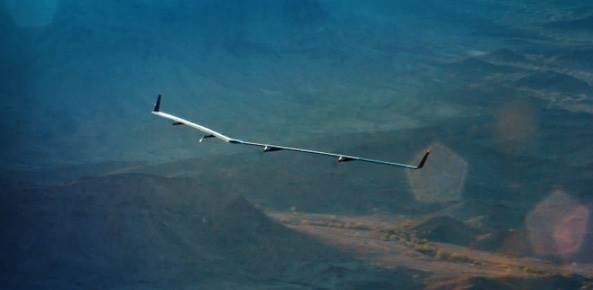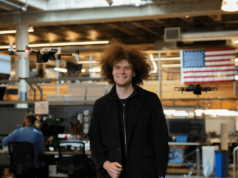Things are looking up for Facebook’s plans to provide high-speed Internet connectivity to virtually everyone on the planet. Not only did a team of scientists from the company figure out how to improve data transmission by laser beams this week, but the social network’s experimental Aquila drone finally had its maiden voyage.
The flight, which was the first full-scale test of the Aquila vehicle, actually took place about three weeks ago at the Yuma Proving Grounds in Yuma, Ariz. The company had been running test flights with a one-fifth scale model of the vehicle for several months, but the June flight represented the first time it had flown a full-scale version of the drone.
Internet from the Sky
During the low-altitude test flight, the drone remained airborne for 96 minutes, the company said, during which time it cruised at an altitude of about 2,150 feet above sea level, while consuming only 2,000 watts of power. The drone is designed to run on solar power during the day and battery power at night.
Eventually, however, the Aquila will reach a regular cruising altitude of 60,000 — 90,000 feet, putting it far above both commercial flight lanes and any inclement weather, all while consuming only 5,000 watts, about the same amount of electricity needed to power a high-end microwave. The drones are designed to be deployed as a fleet of autonomous aircraft capable of delivering Internet connectivity to anyone within a 60-mile communication diameter for up to 90 days at a time.
We spoke with Omar Akhtar, analyst at the Altimeter Group, who told us the Aquila aircraft and the Connectivity Lab in general support the company’s strategy of becoming synonymous with the entire Internet, not just social media. “Facebook wants to be a utility,” Akhtar said.
Although the platform famously began its life as a social network, it has since evolved into a broader content platform. The company’s goal is to leverage its large customer base to become a one-stop-shop for Internet services. “Their strategy is to own the Internet,” Akhtar said. “So if you want be entertained by videos, or order something online, you go to Facebook.”
The Aquila project supports that strategy by addressing the untapped market of people who aren’t yet connected. “The more people are on the Internet, the more likely they are to be on Facebook,” Akhtar told us. “The one big asset social media companies have is their audience. If their audience isn’t growing, they don’t have a business case.”
‘Life-Changing Opportunities’
The Aquila project is part of Facebook’s Connectivity Lab, a program the company established to develop new technologies such as aircraft, satellites, and wireless communications systems, to help bring Internet access to parts of the world that lack connectivity.
“Internet access can offer life-changing opportunities and experiences to all of us, but there are still 4 billion people without it,” Jay Parikh, Facebook’s global head of engineering and infrastructure wrote yesterday in a blog post about the flight. “That’s 60 percent of the global population. As many as 1.6 billion of those unconnected people live in remote locations with no access to mobile broadband networks, where implementing existing network technologies is so challenging and costly that it will take years to bring everyone affordable access.”
Once deployed, the drones will use free space lasers for communication between aircraft in the fleet, as well as e-band technology to beam connectivity from the airplane to receivers on the ground. While free space laser technology has long offered significant promise for high-speed communications, the engineering challenges inherent in maintaining a steady light signal at long-distances and through variable atmospheric conditions has prevented its deployment.
But that seems to be an obstacle the company has already overcome. Earlier this week, scientists working at the Connectivity Lab published a paper on a new technique to power free space laser communications at distances of more than 10 miles at speeds of up to 100 Gbps.







